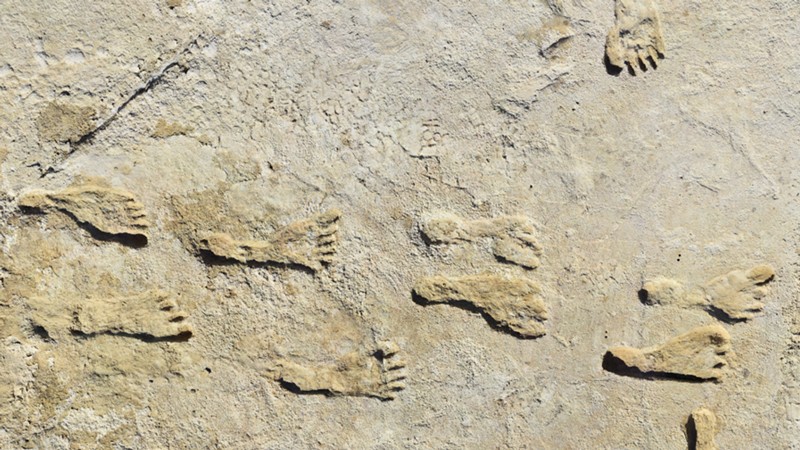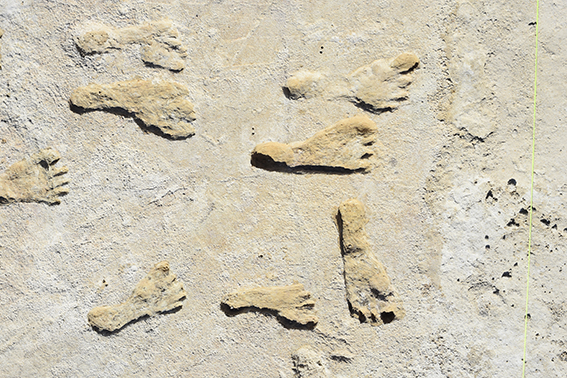Footprints left behind in layers of clay and silt at New Mexico’s White Sands National Park may be between 23,000 and 21,000 years old. That’s based on radiocarbon dating of the remains of grass seeds buried in the layers of sediment above and below the tracks. If the dates are correct, the tracks are evidence that people walked beside the now-dry Lake Otero during the height of the last ice age, when kilometers of ice covered the northern half of the continent. And that would mean that people must have arrived in North America—and made their way to an area well south of the ice—before the ice sheets expanded enough to close off the route.
Arriving ahead of the ice sheets
Bournemouth University archaeologist Matthew Bennett and his colleagues found a total of 61 human footprints east of an area called Alkali Flat, which was once the bed and shoreline of an ancient lake. Over time, as the lake’s edge expanded and contracted with shifts in climate, it left behind distinct layers of clay, silt, and sand. Seven of those layers, in the area Bennett and his colleagues recently excavated, held human tracks along with those of long-lost megafauna.
Some of the sediment layers contained the remains of ancient grass seeds mixed with the sediment. Bennett and his colleagues radiocarbon-dated seeds from the layer just below the oldest footprints and the layer just above the most recent ones. According to the results, the oldest footprints were made sometime after 23,000 years ago; the most recent ones were made sometime before 21,000 years ago. At that time, the northern half of the continent was several kilometers below massive sheets of ice.
The ice sheets had completely blanketed most of Canada and the northernmost US around 26,000 years ago, and they wouldn’t begin to thaw and recede until around 20,000 years ago.
“These data provide definitive evidence of human occupation of North America south of the Laurentide ice sheet during the Last Glacial Maximum,” wrote Bennett and his colleagues in their recent paper. And anyone who lived in what’s now New Mexico during this period, known as the Last Glacial Maximum, must have arrived before the ice sheets closed off the route from Asia into the Americas.
If that’s the case, we may have to rethink our species’ role in the extinction of megafauna like mammoths and giant ground sloths—again. “This also raises the possibility of a human role in poorly understood megafauna extinctions previously thought to predate their arrival,” wrote Bennett and his colleagues.
The search for the first Americans
North and South America were the last continents settled by humans; as far as we know, none of our other hominin relatives ever got there at all. At the moment, the oldest widely accepted evidence of people in the Americas comes from a scattering of sites along the west coasts of both continents, and it ranges from 13,000 to 16,000 years old.
Our understanding of how and when people ventured into the Americas has changed drastically in recent years. Until about a decade ago, it seemed as if the first Americans were part of the Clovis culture, named for the distinctive projectile points they left behind near what’s now Clovis, New Mexico. All the available evidence indicated that the Clovis people made their way southward through a corridor that opened up in the middle of the ice sheets around 13,000 years ago.
But then, as is usually the case (at least on a good day), archaeologists found new evidence, like a 14,000-year-old set of footprints in Argentina, a single 14,600-year-old footprint in Chile, a 14,500-year-old site in Florida, and stone tools dating to 16,000 years ago in western Idaho. That evidence pushed the date of arrival back a few thousand years, suggesting that the Clovis people were actually not the first to arrive. It also made it look much more like that the first Americans had actually skirted the edge of the ice sheets along the Pacific coast.
At the moment, the bulk of the evidence suggests that people arrived in North America around 16,000 years ago and followed the coastline to the land south of the ice sheets. However, if Bennett and his colleagues are correct, the recently unearthed tracks at White Sands could drastically change what we think we know yet again. Twenty-three-thousand-year-old footprints can only mean that people were already living in what’s now New Mexico before the ice sheets sealed off the southern half of the continent from the rest of the world for the next few thousand years. It’s possible—even likely—that another wave of newcomers arrived as the ice sheets receded again, but there may already have been someone here to meet them.
Evidence for extraordinary claims
Extraordinary claims require extraordinary evidence, as the late astronomer Carl Sagan would say. And Bennett and his colleagues are certainly making an extraordinary claim. If there’s going to be scientific debate about the White Sands tracks, it’s likely to center on the dating of the sediment layers involved.
The seeds mixed into the layers above and below the White Sands tracks provided a handy way to date the tracks. But aquatic plants, like the species of grass that Bennett and his colleagues dated, can sometimes look older than they are. If the water is full of dissolved calcium carbonate from much older diatoms or other aquatic life, that can make the ratio of carbon-14 in the plants appear too low. This is called a hard-water effect (or a reservoir effect).
To check their results, Bennett and his colleagues compared radiocarbon dates from terrestrial and aquatic plants in the area around Alkali Flat. The aquatic dates matched the terrestrial ones, which means the aquatic plants that grew in the area for several thousand years probably weren’t suffering from a hard-water effect.
The new claim is also less far-fetched and supported by much firmer evidence than some others. For instance, a group of archaeologists in California insist that they found a 130,000-year-old mammoth-butchering site, which would put humans in California long before we have any evidence that our species had even made it as far out of Africa as Europe. And the case for the improbably old California site depends entirely on whether some round stones had been used as hammers.
Meanwhile, the 23,000-year-old tracks at White Sands appear to line up well with a paper published last year, which described stone tools unearthed from a 30,000-year-old layer of sediment in a cave in Mexico.
Ice age errands
If people were walking around New Mexico during the Last Glacial Maximum, who were they and what were they doing? Based on what their foot measurements tell us about their stature, most of the people who left the tracks at White Sands appear to have been teenagers and children. If that’s correct, they might have been fetching water or gathering up food or other resources.
“One hypothesis for this is the division of labor, in which adults are involved in skilled tasks whereas ‘fetching and carrying’ are delegated to teenagers. Children accompany the teenagers,” wrote Bennett and his colleagues.
Most of the kids’ feet appear to be flatter than those of most people living today, which suggests that they often went barefoot. The toes of the tracks seem stretched a bit, which usually happens when someone slips while walking, such as on a muddy lakeshore.
The environment at White Sands was, for thousands of years, perfect for preserving footprints. Last year, the same team of researchers found the 10,000- to 15,000-year-old tracks of a teenager or short woman crossing paths with mammoths and giant ground sloth while carrying a small child. In 2019, the researchers used radar to spot hidden tracks. And in 2018, they tracked the steps of hunters pursuing giant sloths.
Science, 2021 DOI: https:/10.1126/science.abg7586; (About DOIs).



3175x175(CURRENT).thumb.jpg.b05acc060982b36f5891ba728e6d953c.jpg)


Recommended Comments
There are no comments to display.
Join the conversation
You can post now and register later. If you have an account, sign in now to post with your account.
Note: Your post will require moderator approval before it will be visible.